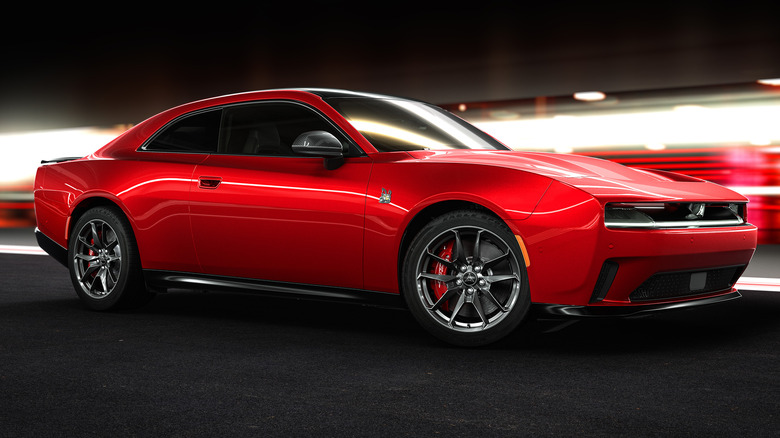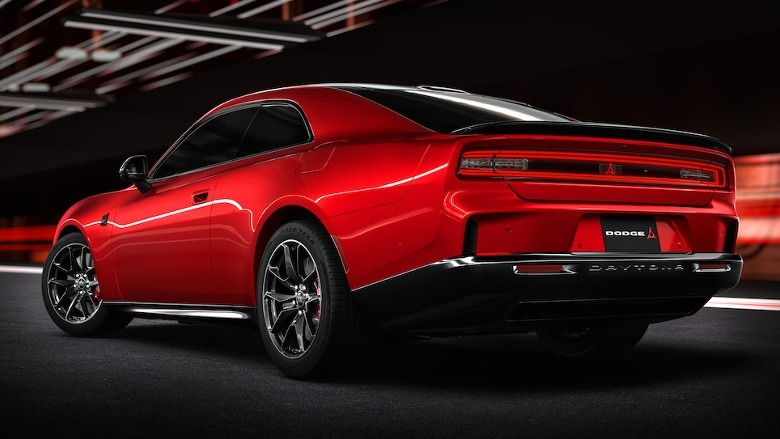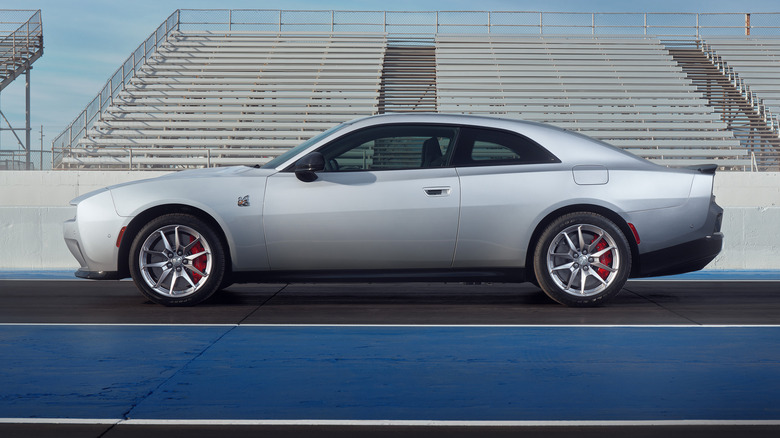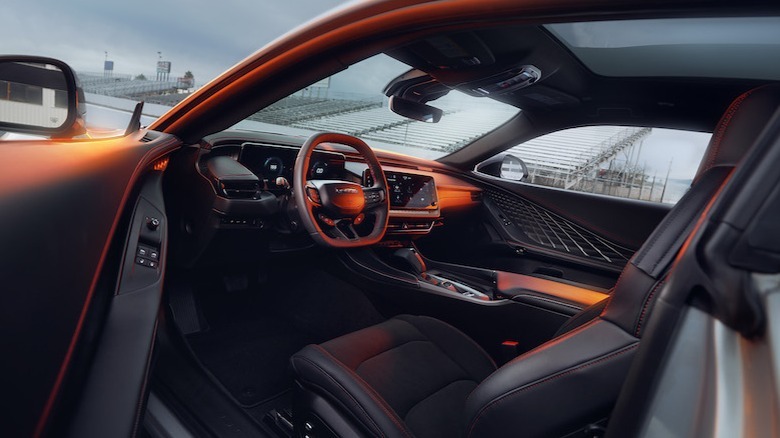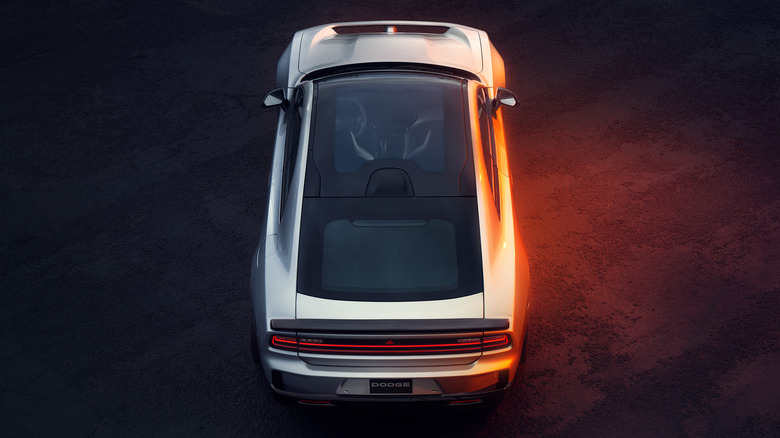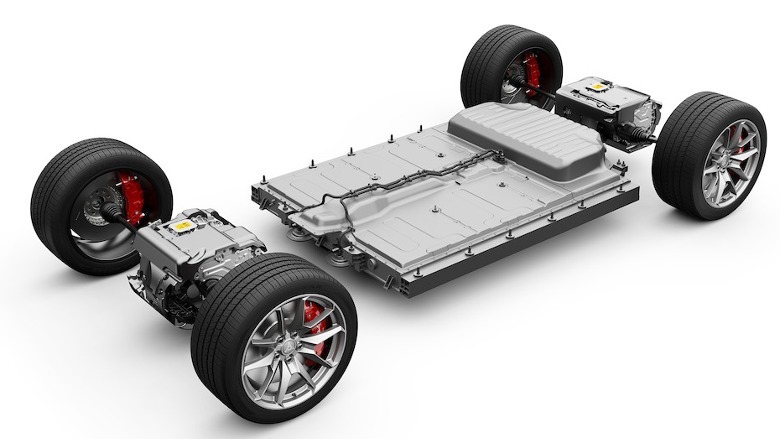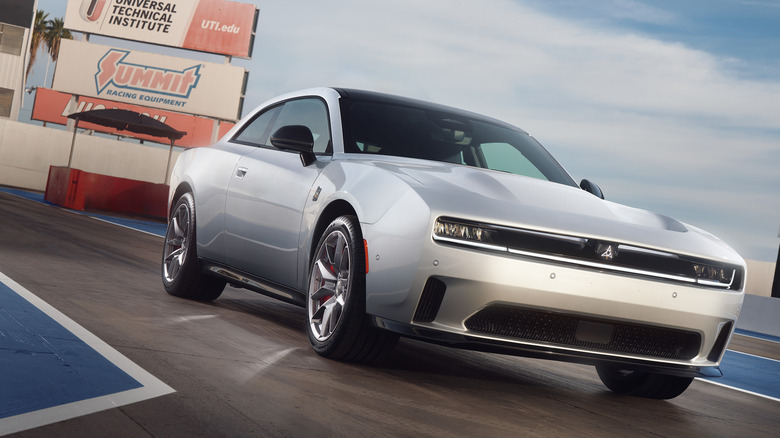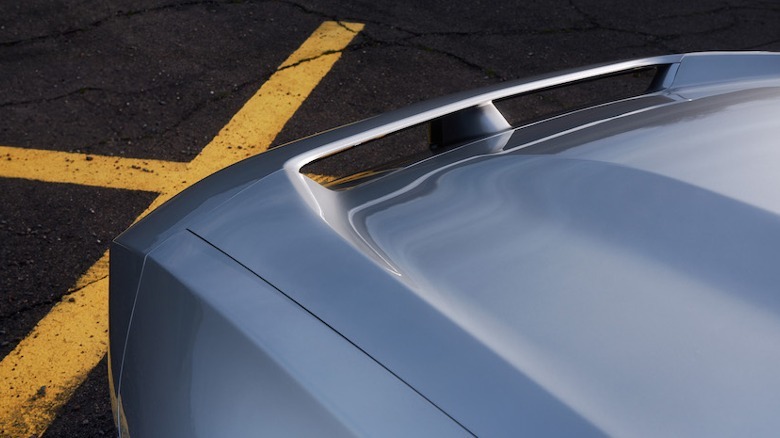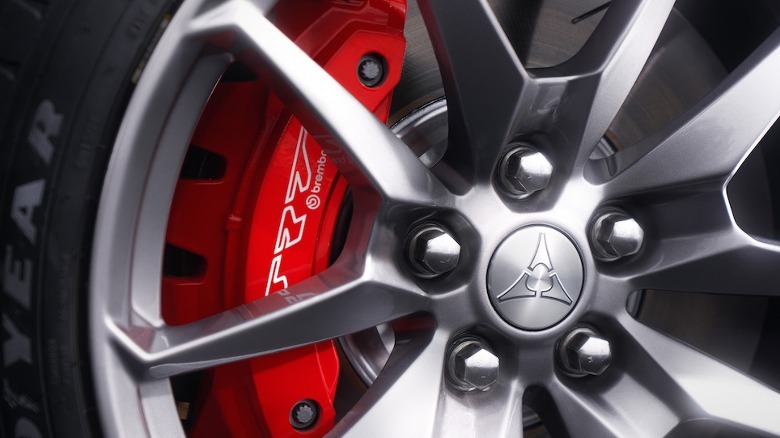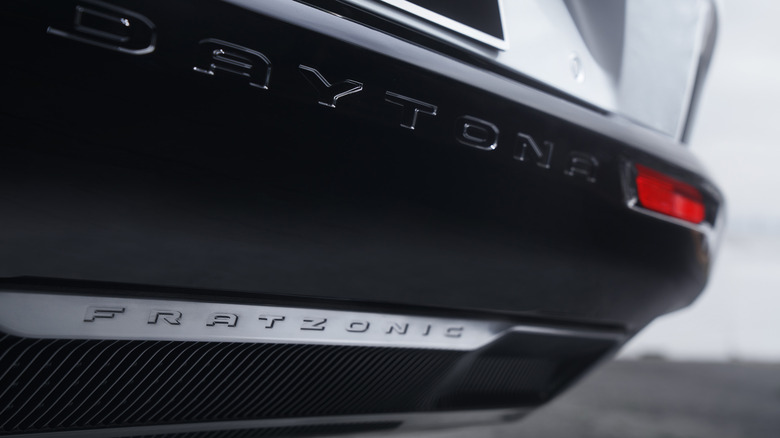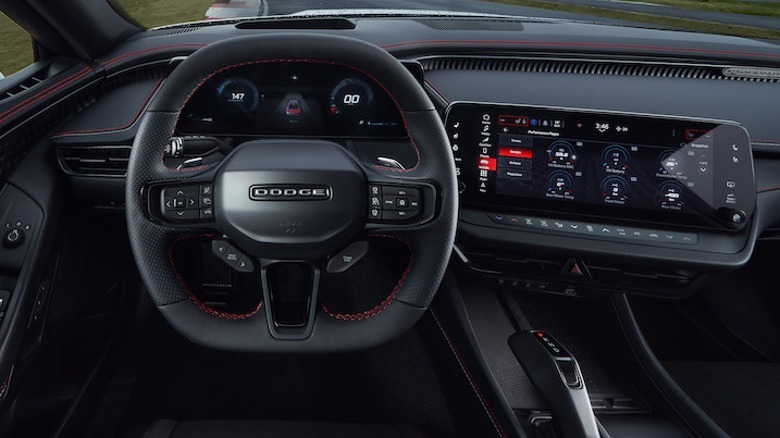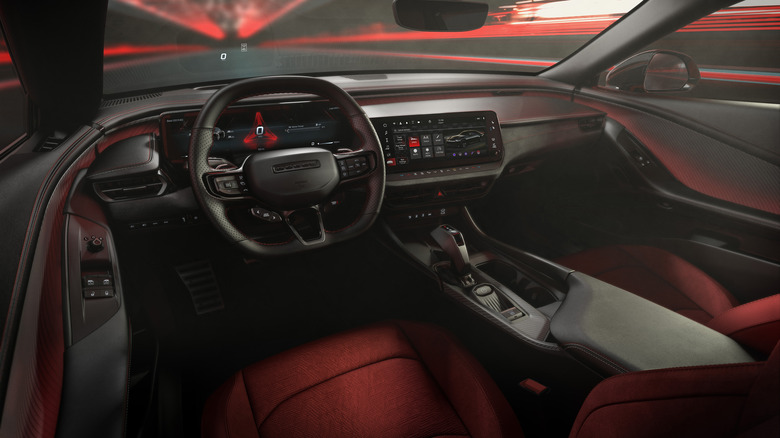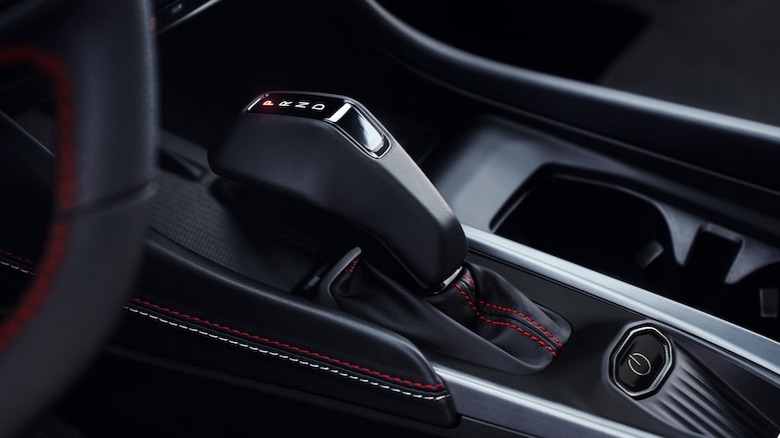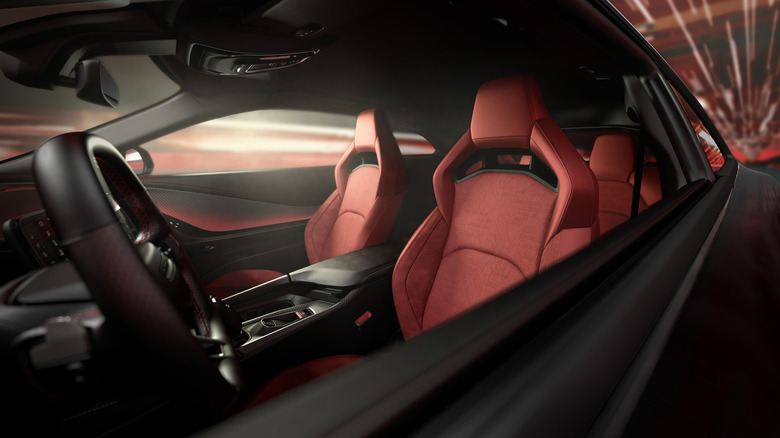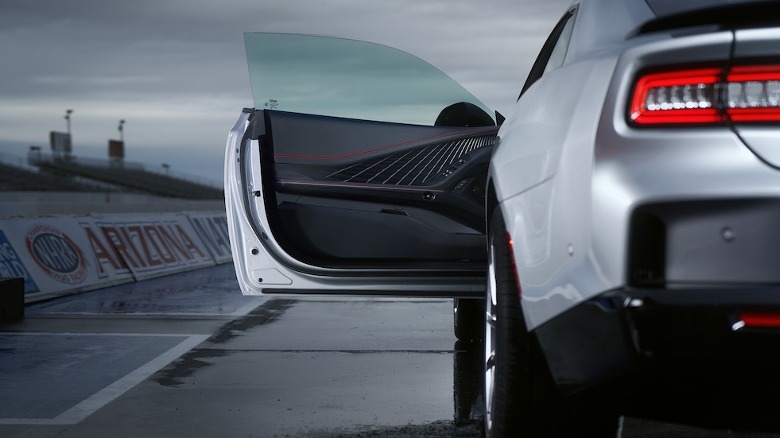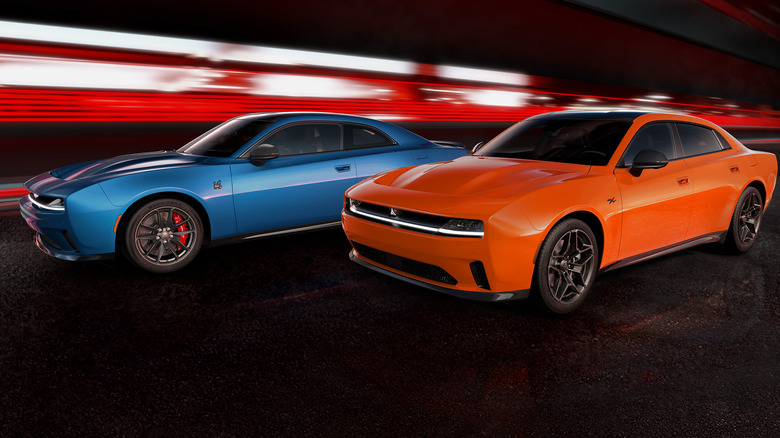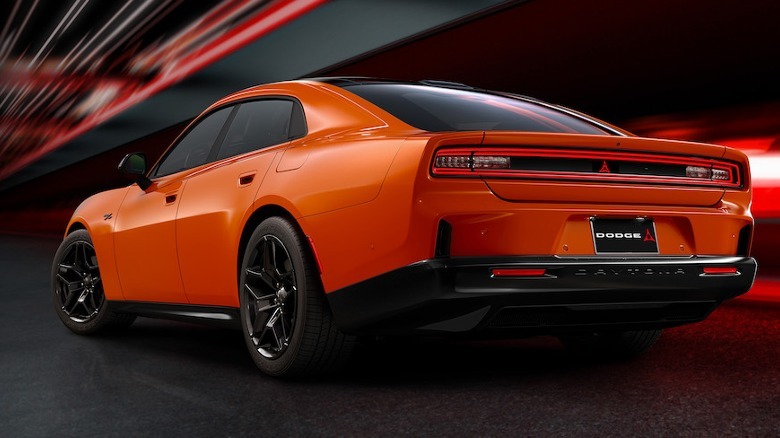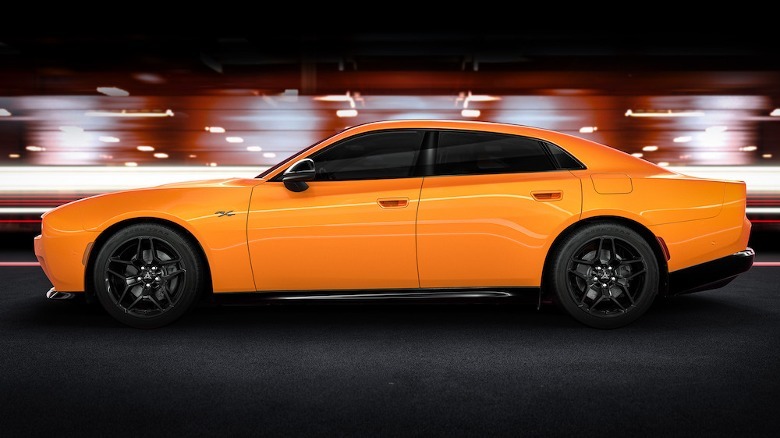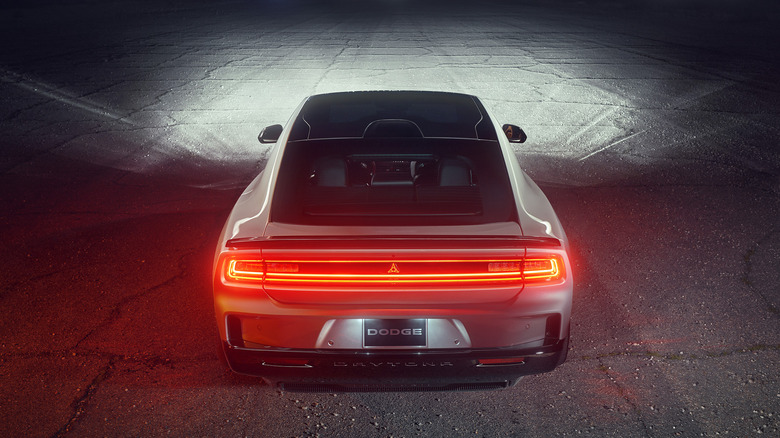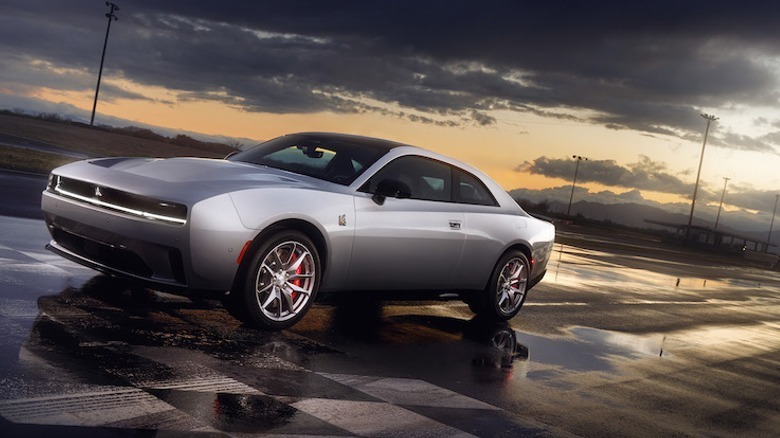2024 Dodge Charger Daytona Revealed As Electric Muscle Car That Can Outrun A Hellcat Redeye
The 2024 Dodge Charger Daytona is going electric, and Dodge is dragging what we think of as a muscle car along with it. More specifically, it's aiming to reinvent it as a dual-motor all-wheel drive EV beast, tapping as much as 670 horsepower to embarrass even the current Hellcat Redeye. At first glance, though, you might think the automaker accidentally rolled out its 2022 Charger Daytona SRT Concept again.
"That was the production car, hiding in plain sight," Tim Kuniskis, CEO of Dodge, said at a preview of the new Charger Daytona last month. While there are a few exterior differences — and the cabin is apparently about 90% the same as that of the concept — Dodge made a conscious decision to effectively all but reveal its first fully-electric vehicle 18 months ago. That, Kuniskis put bluntly, was all about giving the automaker's most fervent fans and customers time to get onboard — and get the EV angst out of their system.
Those ICE-enthusiasts needed "soak time," the Dodge CEO said, "to internalize how we were going to electrify." Considering the reaction — both to the original news that Dodge would, indeed, be shifting away from internal combustion and to the Charger being electrified specifically — that probably wasn't an unwise strategy. Whether, even after all that time, potential 2024 Charger Daytona buyers will be onboard with Dodge's electric vision remains to be seen.
Destroying today's Scat Pack
Dodge certainly isn't leaving sales success to chance, and it's putting its best foot forward. Based on the new Stellantis STLA Large Platform — an architecture designed with not only EV but ICE and hybrid drivetrains in mind — the 2024 Charger Daytona will eclipse the current car from day one. Initially offered in two-door form with a hatchback trunk, and with a four-door version expected from Q1 2025, sales will kick off in mid-2024 of two versions.
The 2024 Dodge Charger Daytona R/T will be the initial entry-level model, with 400V electric all-wheel drive as standard courtesy of a pair of motors. There'll be 456 horsepower (340 kW) normally and 404 lb-ft of torque, though a Power Shot mode will push that to 496 horsepower (370 kW) for a 15-second boost (there's a 30-second wait period between each burst). 0-60 mph will clock in at 4.7 seconds, Dodge says, with an estimated 13.1 second quarter-mile time.
The Charger Daytona Scat Pack sticks with all-wheel drive but bumps the electric motor output to 630 horsepower (470 kW) and 627 lb-ft of torque, with 670 hp (500 kW) in Power Shot mode. That cuts the 0-60 time to 3.3 seconds and the quarter-mile to an estimated 11.5 seconds.
"This is gonna destroy what we call the Scat Pack today," Kuniskis concluded. It's worth noting that, to begin with, Dodge will be outfitting the new R/T with the Direct Connection Stage 1 upgrade kit (contributing 40 hp of that total power) and the Scat Pack with the Stage 2 kid (responsible for 80 hp). In the future, Dodge will offer those kits separately, with forthcoming base models down in power from the earliest cars.
Think performance, not range
With instantaneous torque delivery, the Scat Pack will be "still the quickest and most powerful muscle car you can buy at launch," the Dodge CEO said, capable of out-accelerating a current Hellcat Redeye Widebody. While the existing Challenge and Charger require pulling into a gas station to refuel, the Charger Daytona will support up to 183 kW DC fast charging (or 11 kW Level 2 home charging) for its 100.5 kWh battery (of which 93.9 kWh is usable).
It's a big battery pack — a li-ion using nickel cobalt aluminum chemistry — with an equally big 550 kW peak discharge rate. That, Dodge says, ensures the motors will never go wanting for energy during track days or drag races. With a focus on performance rather than frugality, mind, range unsurprisingly suffers. Expect 317 miles from the R/T and 260 miles from the Scat Pack.
28 minutes should take the battery from 20-80% at a suitably potent DC fast charger. The front motor supports axle disconnect for saving energy, while the rear gets a standard mechanical limited-slip differential (LSD) for controlling left-to-right power.
Aesthetics like no other EV
Inspired by the 1968 Charger, the 2024 Charger Daytona's exterior won't be mistaken for anything other than a Dodge muscle car. It's big, for a start — over 17 feet long and more than 6.6 feet wide, with a curb weight of 5,838 pounds — and while its slab-sided proportions clearly have softened from the current Challenger, it's no aero-smoothed blob like some EVs. An R-Wing pass-through at the leading edge of the hood improves downforce (and, in fact, aero performance is apparently 25% better than the outgoing car) while illuminated Fratzog logos and full-width light bars front and rear debut Dodge's new branding aesthetic. There are more subtle Dodge logos etched into the headlamp clusters.
Nine-wheel designs kick off with 18x8 silver alloys on the Dayton R/T, and 20x11 satin carbon allows on the Daytona Scat Pack. The latter's Track Package throws on staggered Goodyear Eagle F1 Supercar 3 305/35ZR20XL front and 325/35ZR20 rear tires along with 16-inch Brembo vented brake rotors and red-painted six-piston front and four-piston rear calipers: Dodge's biggest tire and brake package so far.
Of course, there's also regenerative braking with a choice of three levels — 0.1g, 0.2g, or 0.3g — controlled by steering wheel paddles. The R/T's multi-link suspension gets monotube touring shocks, while the Scat Pack gets versions tweaked for improved control. With the Track Pack, they're swapped for dual valve adaptive shocks, with individually tuned compression and rebound for an uptick in comfort on the road and performance on the track.
What does an electric muscle car sound like?
Potentially most controversial (as the concept demonstrated) is how the Charger Daytona will sound. Dodge's Fratzonic Chambered Exhaust — effectively a resonance chamber at the rear of the car with speakers inside, producing a noise dependent on the drive conditions and with the potential decibel output to match the current ICE Hellcat — will be standard. "If you're a muscle car enthusiast, there's something subliminal which makes you feel comfortable," CEO Kuniskis says, with the faux-exhaust apparently matching the beat, cadence, and tempo of a HEMI's firing order. Or, a Stealth mode will allow drivers to turn it off altogether.
It'll be controlled via an all-new dashboard, with a significant uptick in tech compared to Dodge's current cars. A 12.3-inch central touchscreen running Uconnect 5 is standard, with custom Daytona menus for things like optional 64-zone "Attitude Adjustment" ambient lighting, drive mode settings, and the new, optional Drive Experience Recorder (DxR), which can capture 1080p front camera video, in-cabin audio, and drive metrics including GPS and a cloud-based leaderboard. That's all saved to a USB drive and can be reviewed on the touchscreen, Dodge's phone app, and exported to a computer.
A much-needed dashboard tech upgrade
Wireless Apple CarPlay and Android Auto are standard, along with dual-zone climate control and a 506W Alpine nine-speaker audio system. There are also optional heated seats and a heated flat top/bottom steering wheel, SiriusXM, dual simultaneous Bluetooth phone connectivity, TomTom navigation with EV charging data, Alexa, and both a smartphone digital key and an NFC key card.
A 914W Alpine 18-speaker audio upgrade with a subwoofer will be available. Dodge's standard seats will be cloth and vinyl, but leather, along with a high-back fixed headrest seat with pass-through, are available in the Plus, Track, and Carbon & Suede packages. A 10.25-inch digital driver display is standard, with a 16-inch version and a head-up display both available.
All of those new displays get custom graphics depending on drive mode, along with individual driver customization supported. Along with Auto, Eco, Sport, and Wet/Snow, there'll also be Track and Drag on the Charger Daytona Scat Pack: the former optimizes for smooth race surfaces, the latter for straight-line acceleration.
Donuts, drifting, and general hooliganism
Donut Mode and Drift Mode — also Scat Pack exclusives — help tame the traction control and adjust things like slip angle and torque based on whether you want to go in a circle or sideways. Line Lock will lock the front wheels so as to spin the rears to clean and warm them; Launch Control optimizes straight-line acceleration with five levels of intensity. Then there's Race Prep, which includes adjustments to battery preconditioning depending on whether instant peak performance or greater extended performance is required.
What you won't be able to do is shut off the front motors entirely and turn the Charger Daytona into a rear-wheel drive replica, though Drift Mode will change the slip between the front and back axles. And those EPA range numbers will obviously take a hit if you push hard, whether on the road or at the track, though Kuniskis doesn't think that's an issue.
"What's the fuel efficiency of a muscle car?" the Dodge CEO asked rhetorically. "Nobody knows. It's terrible. Terrible! But that's not why you bought it, and that's not why you'll buy this."
A 4-Door and a Banshee still to come
The reason you might not buy a 2024 Dodge Charger Daytona is because of what's still to come. For a start, there's the four-door version — which will have the same 22.8 cu-ft of trunk space (or 37 cu-ft with the rear seats flat),1.5 cu-ft front trunk, and interior space, but make accessing the rear seats easier — and which will boast the same performance as the two-door R/T and Scat Pack models. It'll arrive as the model year 2025 Charger Daytona 4-Door next year.
Also, in early 2025, the range will be joined by internal combustion versions. Badged the 2025 Dodge Charger Sixpack — saving "Daytona" for the EVs — there'll be two tunes of the 3.0-liter Twin Turbo inline-six Hurricane gas engine we've already tried in the 2025 Ram 1500 and other vehicles. That'll offer either 420 horsepower or 550 horsepower, standard AWD (with the ability to shut off the front axle and drive as RWD alone), and an 8-speed automatic transmission. While they might be down two cylinders from the current V8 HEMI, the Hurricane will still best that on power.
Finally — and most exciting — is the upcoming Dodge Charger Daytona SRT Banshee. Set to be (for the moment) the most potent of the line-up, it'll have 800V architecture and a two-speed eRupt transmission. Full details will have to wait until closer to launch, however.
The biggest Charger Daytona question remains
Similarly unclear right now is pricing, and that's going to be a big deal. According to Dodge CEO Tim Kuniskis, just how much the new Charger Daytona will cost is still a matter of internal debate — in fact, "debating is a nice word," according to Kuniskis — but whatever is settled upon, it seems unlikely to match the pricing of the outgoing gasoline Chargers.
Say what you like about Dodge's current muscle cars, but they've long offered an impressive power-per-dollar balance. A 2023 Challenger R/T, for example, gets you 375 hp and serious presence from under $42k (plus destination), while the 485 hp Scat Pack version still lands under $50k. Even special editions, like the Challenger Swinger that SlashGear reviewed, pack a pricing punch.
Dated technology is, undoubtedly, the key to why Dodge can keep prices so low (the outgoing Challenger range actually starts at under $33k!), but it's also the reason why the eventual sticker on the Charger Daytona seems destined to cause as many upsets at the absence of a V8. A 100 kWh battery alone is an expensive component, and Stellantis has been upfront about expecting its EVs to be profitable rather than artificially subsidized.
Dodge could've used that as an excuse to play the Charger EV safe or even to borrow Ford's strategy and use the familiar nameplate on something a lot more mainstream, like a performance SUV. That its first electric vehicle is so atypical, then, feels like a good thing overall — even if not everybody may want or afford one. "They told us we couldn't sell HEMIs," Kuniskis concluded, "but they never told us we had to be boring and slow."
